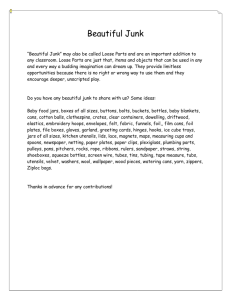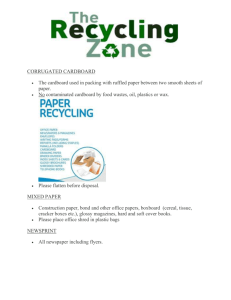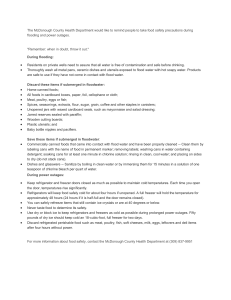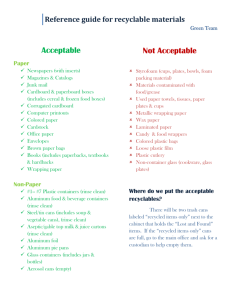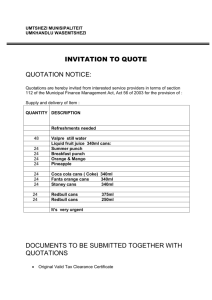Archery Contest1 Your group decided to investigate the
advertisement
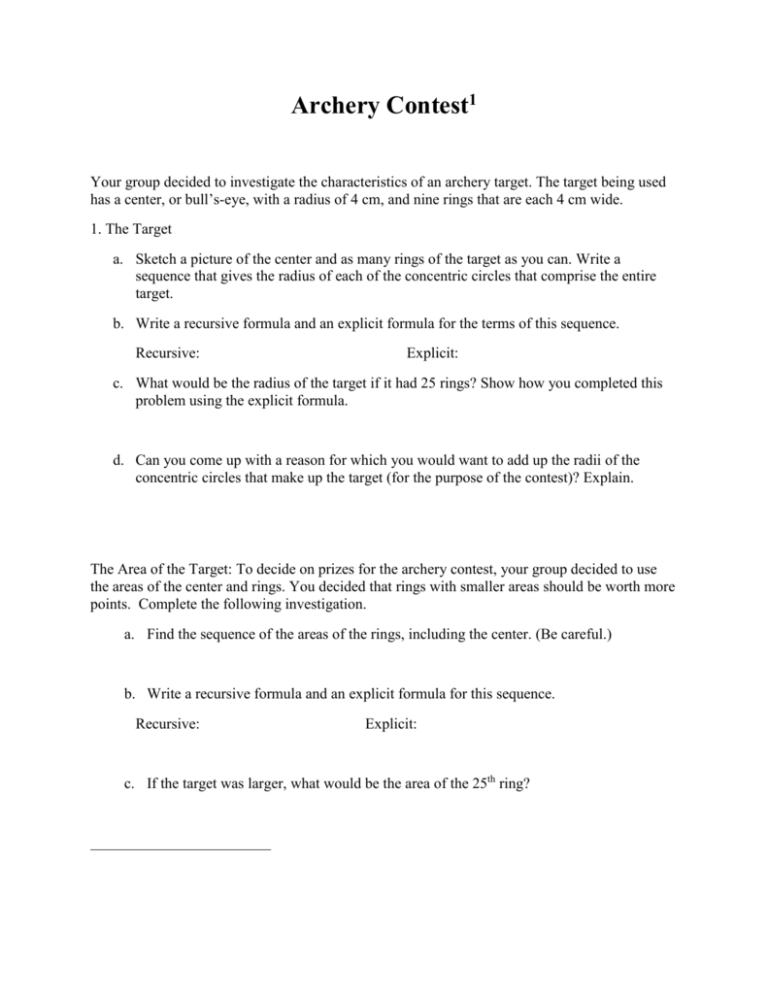
Archery Contest1 Your group decided to investigate the characteristics of an archery target. The target being used has a center, or bull’s-eye, with a radius of 4 cm, and nine rings that are each 4 cm wide. 1. The Target a. Sketch a picture of the center and as many rings of the target as you can. Write a sequence that gives the radius of each of the concentric circles that comprise the entire target. b. Write a recursive formula and an explicit formula for the terms of this sequence. Recursive: Explicit: c. What would be the radius of the target if it had 25 rings? Show how you completed this problem using the explicit formula. d. Can you come up with a reason for which you would want to add up the radii of the concentric circles that make up the target (for the purpose of the contest)? Explain. The Area of the Target: To decide on prizes for the archery contest, your group decided to use the areas of the center and rings. You decided that rings with smaller areas should be worth more points. Complete the following investigation. a. Find the sequence of the areas of the rings, including the center. (Be careful.) b. Write a recursive formula and an explicit formula for this sequence. Recursive: Explicit: c. If the target was larger, what would be the area of the 25th ring? d. Find the total area of the bull’s eye by adding up the areas in the sequence. e. Sometimes, we do not have all the terms of the sequence but we still want to find a specific sum. For example, we might want to find the sum of the first 15 multiples of 4. Write an explicit formula that would represent this sequence. Is this an arithmetic sequence? If so, how could we use what we know about arithmetic sequences and the sum formula in (e) to find this sum? Find the sum. f. What happens to the sum of the arithmetic series we’ve been looking at as the number of terms we sum gets larger? How could you find the sum of the first 200 multiples of 4? How could you find the sum of all the multiples of 4? Explain using a graph and using mathematical reasoning. g. Let’s practice a few arithmetic sum problems. 1. Find the sum of the first 50 terms of 15, 9, 3, -3, … 2. Find the sum of the first 100 natural numbers 3. Find the sum of the first 75 positive even numbers Point Values: Assume that each participant’s arrow hits the surface of the target. a. Determine the probability of hitting each ring and the bull’s-eye. Target Piece Bull’s Eye Ring 1 Ring 2 Ring 3 Ring 4 Ring 5 Ring 6 Ring 7 Ring 8 Ring 9 Area of Piece (in cm2) 16 48 80 112 144 176 208 240 272 304 Probability of Hitting this Area b. Assign point values for hitting each part of the target, justifying the amounts based on the probabilities just determined. Rock Throwing Contest2 For the rock throwing contest, your group decided to provide three different arrangements of cans for participants to knock down. 1. For the first arrangement, the tin cans were set up in a triangular pattern, only one can deep. (See picture.) a. If the top row is considered to be row 1, how many cans would be on row 10? b. Is this an arithmetic or a geometric sequence (or neither)? Write explicit and recursive formulas for the sequence that describes the number of cans in the nth row of this arrangement. c. It is important to have enough cans to use in the contest, so your group needs to determine how many cans are needed to make this arrangement. Make a table of the number of rows included and the total number of cans. Rows Included 1 2 3 4 5 6 7 8 Total Cans 1 3 d. One of your group members decides that it would be fun to have a “mega-pyramid” 20 rows high. You need to determine how many cans would be needed for this pyramid, but you don’t want to add all the numbers together. One way to find the sum is to use the summation formula. Find the sum of a pyramid arrangement. n We can also write this problem using summation notation: a , where i is the index of i 1 i summation, n is the upper limit of summation, and 1 is the lower limit of summation. We can 20 think of ai as the explicit formula for the sequence. In this pyramid problem, we have i i 1 because we are summing the numbers from 1 to 20. We also know what this sum is equal to. 20 n 20 i a1 an 1 20 . What if we did not know the value of n, the upper limit but we 2 2 i 1 did know that the first number is 1 and that we were counting up by 1s? We would then have n n n 1 n . This is a very common, important formula in sequences. We will use i 1 n 2 2 i 1 it again later. e. Propose and justify a specific number of cans that could be used in this triangular arrangement. Remember, it must be realistic for your fellow students to stand or sit and throw a rock to knock down the cans. It must also be reasonable that the cans could be set back up rather quickly. Consider restricting yourself to less than 50 cans for each pyramid. Describe the set-up and exactly how many cans you need. 2. For the second arrangement, the group decided to make another triangular arrangement; however, this time, they decided to make the pyramid 2 or 3 cans deep. (The picture shows the 2-deep arrangement.) a. This arrangement is quite similar to the first arrangement. Write an explicit formula for the sequence describing the number of cans in the nth row if there are 2 cans in the top row, as pictured. b. Determine the number of cans needed for the 20th row. c. Similar to above, we need to know how many cans are needed for this arrangement. How will this sum be related to the first time we took the sum? The formula given above in summation notation only applies when we are counting by ones. What are we counting by to determine the number of cans in each row? What if the cans were three deep? What would we be counting by? In this latter case, how would the sum of the cans needed be related to the sum of the cans needed in the arrangement in problem 1? n n i 1 i 1 d. This leads us to an extremely important property of sums: cai c ai , where c is a constant. What does this property mean? Why is it useful? e. Suppose you wanted to make an arrangement that is 8 rows high and 4 cans deep. Use the property in 2e to help you determine the number of cans you would need for this arrangement. f. Propose and justify a specific number of cans that could be used in this triangular arrangement. You may decide how many cans deep (>1) to make the pyramid. Consider restricting yourself to less than 50 cans for each pyramid. Describe the set-up and exactly how many cans you need. Show any calculations. 3. For the third arrangement, you had the idea to make the pyramid of cans resemble a true pyramid. The model you proposed to the group had 9 cans on bottom, 4 cans on the second row, and 1 can on the top row. a. Complete the following table. Row Number of Cans 1 2 3 4 5 6 7 8 9 10 1 4 9 Change from Previous Row 1 3 5 b. How many cans are needed for the nth row of this arrangement? c. What do you notice about the numbers in the third column above? Write an equation that relates column two to column three. Then try to write the equation using summation notation. d. How could you prove the relationship you identified in 3c? e. Let’s look at a couple of ways to prove this relationship. Consider a visual approach to a proof.3 Explain how you could use this approach to prove the relationship. f. We know that the sum of the first n natural number is 1 2 3 ... n n n 1 n n 1 2 , so . If we multiply both sides of the equation by 2, we get the sum 2 of the first n EVEN numbers. How can we use this new equation to help us find the sum of the first n ODD numbers? Write out the terms of these series. 4 i. 5i i 1 5 ii. i 6 i 1 5 iii. i 2 3 i 1 You have already seen one sum property. Here are the important properties you need to know. Explain why the two new properties make mathematical sense to you. Properties of sums (c represents a constant) 1. n n i 1 i 1 cai c ai n 2. c cn i 1 3. n n n i 1 i 1 i 1 ai bi ai bi Express each series using summation notation. Then find the sum. iv. 2 + 4 + 6 + … + 24 v. 5 + 8 + 11 + 14 + … + 41 Compute each sum using the properties of sums. 20 vi. 3i 4 i 1 20 vii. 4i i 1 20 viii. 4i i 1



